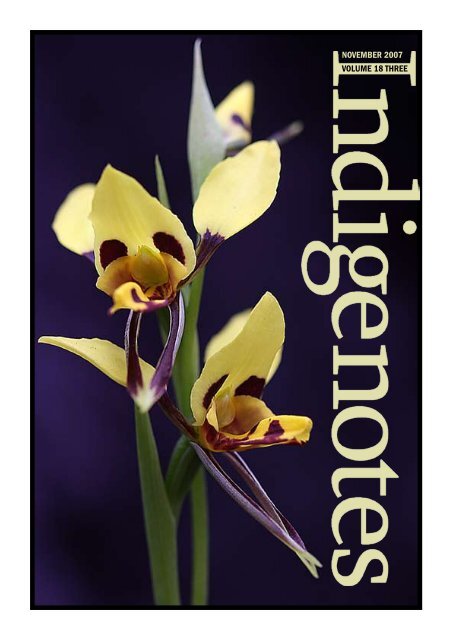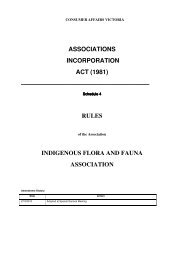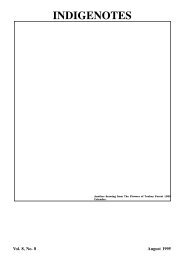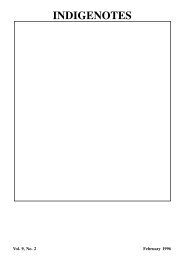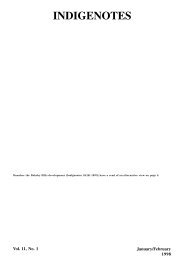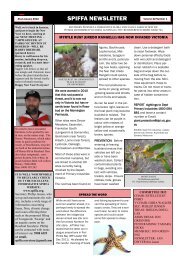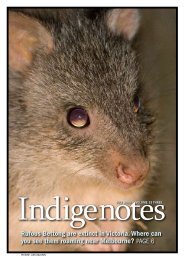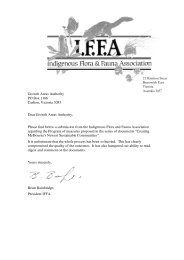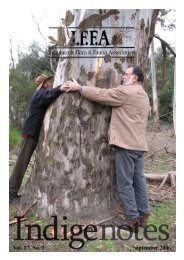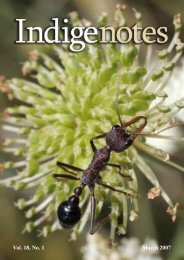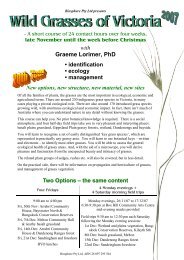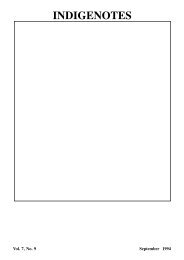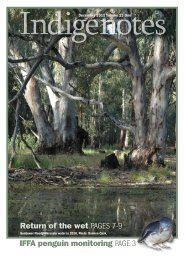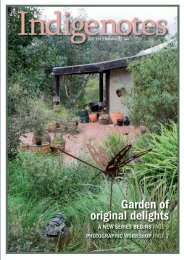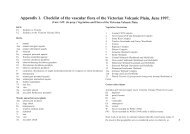here - Indigenous Flora and Fauna Association
here - Indigenous Flora and Fauna Association
here - Indigenous Flora and Fauna Association
Create successful ePaper yourself
Turn your PDF publications into a flip-book with our unique Google optimized e-Paper software.
NOVEMBER 2007<br />
VOLUME 18 THREE<br />
INDIGENOTES VOLUME 18 NUMBER 3
Childhood dream A presidential introduction<br />
A<br />
few years ago I had a recollection that shook me.<br />
I realised I was one of those people who grow up to<br />
be precisely what they dreamed of being as a child.<br />
This might not seem like something to ‘shake’ one, but<br />
it put the lie to my own long-held conviction that I am,<br />
deep down, a person who can never make up their mind. A<br />
conviction persistantly reinforced by friends <strong>and</strong> family.<br />
This memory was of a springtime walk along the Plenty<br />
River in Greensborough w<strong>here</strong> I grew up. Perhaps I was<br />
thirteen years old, which would make it about 1983. I was<br />
on the bend of the river near Partington’s Flat, a sports<br />
field set in a beautiful natural amphitheatre.<br />
Elm trees, Willow <strong>and</strong> old Pear trees from long<br />
ab<strong>and</strong>oned orchards fought above my head for airspace<br />
with Manna Gum <strong>and</strong> Silver Wattle. Watsonia, Ixia <strong>and</strong><br />
Panic grasses skirmished with Poa tussocks <strong>and</strong> a h<strong>and</strong>ful<br />
of other indigenous plants for dominance of the ground.<br />
As I walked, I pondered the botanical battlefield around<br />
me. As you can see, I was kind of precocious when it came<br />
to appreciating the distinction between indigenous <strong>and</strong><br />
exotic plants. I clearly recall thinking how satisfying<br />
it would be to be employed in removing the exotic<br />
vegetation <strong>and</strong> planting back some of the bushl<strong>and</strong><br />
vegetation. For several minutes I transformed the<br />
l<strong>and</strong>scape in that little bend of river in my mind’s eye,<br />
replacing the dusty, dank, shade under the elms with<br />
a dappled, tussocky woodl<strong>and</strong> alive with insects <strong>and</strong><br />
birdlife.<br />
I had a vague sense that some people did do this<br />
as a profession. Probably they did it over in Eltham,<br />
whose environmental <strong>and</strong> artistic achievements filled<br />
out the pages of the Diamond Valley News. Each<br />
week I could read the exploits of the Eltham district<br />
populace <strong>and</strong> its legendary <strong>and</strong> picturesque<br />
environmental pioneers such as Neil Douglas<br />
<strong>and</strong> Clifton Pugh. All the same, I was given<br />
the strong impression that it was the<br />
unemployed, <strong>and</strong> those on community<br />
service orders who were lucky enough<br />
to spend every day in what I felt to be<br />
my ideal occupation. I quietly put away<br />
my daydream, considering that, as this wasn’t<br />
a ‘real’ profession, I couldn’t pursue it as a realistic<br />
career goal.<br />
For over twenty years, I forgot that I had ever had<br />
the daydream at all.<br />
Over the succeeding years, my solitary explorations<br />
steadily reached upstream to the stunning Plenty<br />
Gorge, <strong>and</strong> into Y<strong>and</strong>ell Reserve w<strong>here</strong> I was first<br />
enraptured by native orchids. Eventually I ‘discovered’<br />
the stretch of the old Maroondah aqueduct at St<br />
Helena. The narrow banks of this hundred year<br />
old waterway were over an hour’s hilly walk from<br />
my home. I would arrive tired <strong>and</strong> footsore but<br />
would immediately revive under the spell of a<br />
living dreamscape that drew me back on a score of<br />
weekends. Hordes of Donkey-orchids <strong>and</strong> Sunorchids,<br />
Triggerplants <strong>and</strong> Everlastings replaced<br />
Triggerplant<br />
each other over successive springtime visits. Dozens of<br />
other wildflowers <strong>and</strong> grasses played supporting roles.<br />
In summer I was astonished by glamorous Hyacinth<br />
orchids under the rows of planted Sugar Gums. An eerie<br />
soundtrack was often provided by the local mob of Whitewinged<br />
Coughs.<br />
I was sixteen when all this was destroyed. I heard the<br />
news on the Eclectic Parrot radio show on 3RRR. George<br />
Paras was describing the efforts that had been made to<br />
save this spot from the developers bulldozers. It turned out<br />
I was not the only one who had appreciated this spot. (I<br />
heard a week later that George broke an arm being pushed<br />
into the aqueduct by a bulldozed tree as he rescued plantsthat’s<br />
dedication!). I attended the mangled ruins of the<br />
aqueduct in the following week, experiencing grief that I<br />
would recognise years later as akin to attending the funerals<br />
of much-loved relatives. I know many IFFA members will<br />
have had similar experiences.<br />
In following years I completed a Forest Science degree,<br />
did time working in my parent’s bookshop <strong>and</strong> had a<br />
detour into botanical <strong>and</strong> wildlife illustration before<br />
l<strong>and</strong>ing a position in the Merri Creek Management<br />
Committee’s Parkl<strong>and</strong> Management Team.<br />
am still t<strong>here</strong> ten years later.<br />
I In my roles at MCMC I have controlled<br />
weeds, planted indigenous plants, collected<br />
seed, planned species lists <strong>and</strong> layouts,<br />
conducted vegetation surveys, observed<br />
<strong>and</strong> documented wildlife <strong>and</strong> ecological<br />
processes, assisted Planners <strong>and</strong> Parkl<strong>and</strong><br />
Team Coordinators, designed <strong>and</strong><br />
edited pamphlets <strong>and</strong> publications,<br />
produced displays, maintained a<br />
reference library, conducted<br />
GIS mapping, provided<br />
comments on planning<br />
permits, designed <strong>and</strong> run<br />
community engagement<br />
activities such as planting<br />
days <strong>and</strong> Golden Sun-moth surveys,<br />
liaised with community, Council officers,<br />
contractors <strong>and</strong> crew, students <strong>and</strong> scientists.<br />
It is a diverse, challenging <strong>and</strong> I think<br />
respected occupation (although it is only recently<br />
that some of my family have stopped asking me<br />
when I will get a ‘real’ job). I have also maintained<br />
a small freelance wildlife illustration business <strong>and</strong><br />
have become involved in my local Community House<br />
native garden group <strong>and</strong> committee.<br />
That long-forgotten daydream, among many<br />
thous<strong>and</strong>s that haven’t, eventually became reality. I am<br />
quite pleased that this particular one did.<br />
I have recently had the honour of having been<br />
elected president of IFFA. I am new to its committee<br />
but have already learnt to appreciate its good-natured<br />
an experienced membership. T<strong>here</strong> is much that IFFA<br />
can offer to both old-timers <strong>and</strong> new-comers to the<br />
area of flora <strong>and</strong> fauna management. Reminding our<br />
2<br />
INDIGENOUS FLORA AND FAUNA ASSOCIATION INC
disparate <strong>and</strong> independent-minded community of this fact<br />
will be a major theme in the coming year.<br />
Among the ‘old h<strong>and</strong>s’, the niche of IFFA, among an<br />
increasingly crowded field of journals <strong>and</strong> organisations has<br />
been a topic of intense discussion. I personally value the<br />
IFFA newsletter as a means of learning the preoccupations<br />
of colleagues <strong>and</strong> for its rays of light-heartedness such as<br />
Letter from the suburbs. Over fifty years ago, in his S<strong>and</strong><br />
Country Almanac, Aldo Leopold succinctly described that<br />
“One of the penalties of an ecological education is that<br />
one lives alone in a world of wounds.”(my emphasis).<br />
Thankfully, organisations like IFFA reassure us that while<br />
we may live in a world of wounds, we are not alone in this<br />
perception.<br />
What are your thoughts on what IFFA is now or could<br />
become in the future?<br />
I’d appreciate your ideas.<br />
Brian ‘Prez’ Bainbridge<br />
IFFA’s new Vice President<br />
Vanessa Craigie<br />
My background is in marine ecology but for the<br />
last fifteen years I’ve focussed very much on the<br />
ecology <strong>and</strong> management of native grassl<strong>and</strong>s.<br />
In my private life I maintain an interest in both areas, being<br />
a keen diver <strong>and</strong> an ambitious gardener of native plants of<br />
the Volcanic Plains.<br />
I was a member of IFFA from its earliest days <strong>and</strong> I’m<br />
thrilled to see it arise again from the near-dead. In addition<br />
I’m a member of VNPA, EV, WWF, Friends of the Merri,<br />
Friends of Evans St Grassl<strong>and</strong>, Victorian <strong>Indigenous</strong><br />
Nurseries Cooperative, Project Jonah, Australian Marine<br />
<strong>and</strong> Coastal Society (AMCS) – which makes life a bit<br />
difficult come fund-raising time.<br />
I currently work for the Threatened Species &<br />
Communities section of DSE, <strong>and</strong> I’ve worked in DSE in<br />
its various incarnations <strong>and</strong> names since 1985.<br />
Above: Milkmaids, Burchardia umbellata<br />
Cover: Tiger Orchid, Diuris sulp<strong>here</strong>a, both pictured at the<br />
Grange Heathl<strong>and</strong> Reserve in Clayton South, October 2007.<br />
Pictures: Mick Connolly<br />
IFFA Field Trip<br />
Vegetation Communities of<br />
the Eastern D<strong>and</strong>enongs<br />
Saturday 1 December<br />
Field trip led by Darcy Duggan<br />
Meet at 10:30 am at Selby Community House,<br />
Wombalana Road Selby. Melways Map 75 K11<br />
INDIGENOTES VOLUME 18 NUMBER 3<br />
3
Paddock deep . . .<br />
It was a glorious day, the sun was shining<br />
<strong>and</strong> 14 expectant people met at the<br />
entrance to Bush’s Paddock (Mulla Mulla<br />
Grassl<strong>and</strong>s) equipped with binoculars <strong>and</strong><br />
ID books, while our visiting entomologist,<br />
Ian Faithfull brought his butterfly net <strong>and</strong><br />
collecting kit – we had all the ingredients<br />
for a successful outing.<br />
An overview of the management history of the<br />
paddock was presented by Frances Overmars<br />
from the Pinkerton L<strong>and</strong>care Group, <strong>and</strong> then the<br />
group set out. We made our chequered passage through the<br />
paddock stopping to view whatever caught our attention.<br />
We viewed Ptilotus spathulatus which had survived the<br />
drought despite being planted in the 2006, it had receded<br />
into a neat rosette of deep green leaves, we also viewed the<br />
below ground tuberous roots of the weed, Prairie ground<br />
cherry, no wonder this weed is a survivor. We enjoyed<br />
the brilliant flowering Yellow rush-lily (Tricroyne elatior),<br />
the blue flowering Wahlenbergia, the bright pink flower<br />
of the ever reliable Convolvulus erubescens, Smooth<br />
riceflower ( Pimelea glauca), the Green rock fern (Cheilanthes<br />
austrotenuifolia) <strong>and</strong> the basal leaves of Chocolate lily<br />
(Arthropodium strictum). We found that Grassl<strong>and</strong> Cranesbill<br />
(Geranium retrorsum) had started to grow in response to<br />
the recent scattered rain showers.<br />
The healthiest looking plants grew on <strong>and</strong> around the<br />
basalt rocks, demonstrating the role they play in survival<br />
of the grassl<strong>and</strong> species during drought conditions. We<br />
considered that the roots would have been protected by the<br />
rocks. The Themeda grass had in the main dried out into<br />
a surface covering of brown leaves, resembling minature<br />
grass skirts, <strong>and</strong> since the rain, a few green shoots have<br />
started to appear. The Austrostipa grasses were looking<br />
comparatively healthy, the Red-leg grasses (Bothriochloa<br />
macra) were setting seed as was the Windmill grass (Chloris<br />
truncata) looking almost as if the drought hadn’t occurred.<br />
T<strong>here</strong> was much to learn from the members of the<br />
group which included Ian <strong>and</strong> Tony Faithfull, Dr.Graeme<br />
Lorimer, <strong>and</strong> members of FO Organ Pipes <strong>and</strong> Merri<br />
Creek, the Little River Improvement Society. Many of<br />
the group had experience in managing grassl<strong>and</strong> species<br />
<strong>and</strong> others were specialists in their particular field. Debbie<br />
Reynolds for example, last year completed her BSc honours<br />
degree on the importance of soil disturbance for the<br />
recruitment, growth <strong>and</strong> reproduction of grassl<strong>and</strong> forbs.<br />
We viewed a pretty white spotted butterfly Pieris rapae,<br />
the introduced Cabbage White, <strong>and</strong> two other butterfly<br />
species, the Common Brown Heteronympha merope <strong>and</strong> the<br />
Saltbush Blue Theclinesthes serpentata. The latter was flying<br />
around Atriplex (saltbush) which is a larval host plant.<br />
We saw yellow winged locusts Gastrimargus musicus <strong>and</strong><br />
the Long-headed Grasshopper or Giant Green Slantface<br />
(misleading name, since the ones seen were brown) Acrida<br />
conica. Ian found a matchstick grasshopper, probably<br />
V<strong>and</strong>iemenella viatica, a small wingless species in the family<br />
Morabinae. This group is of special interest because it<br />
has been intensively studied by geneticists <strong>and</strong> others<br />
interested in speciation. V. viatica has at least 12 different<br />
chromosomal races, which apparently do not overlap in<br />
their distribution but form narrow hybrid zones w<strong>here</strong><br />
races meet <strong>and</strong> interbreed. Whitefringed Weevils Naupactus<br />
leucoloma were common. This is a South American pest<br />
species which attacks clovers <strong>and</strong> lucerne in particular, <strong>and</strong><br />
is likely to be damaging to seedlings of native forbs. We<br />
looked under the scattered tiles for Striped Legless Lizards,<br />
but had no luck.<br />
Graeme Lorimer told us how the currents of salt laden<br />
air from Port Phillip Bay, striking Mt. Cotterell, the highest<br />
point on the basalt plains, may effect the plant species on<br />
the Mount <strong>and</strong> that some of them may have adapted to<br />
these conditions.<br />
We had initially decided to have morning tea in the<br />
paddock, however, it was past 1pm before we paused, <strong>and</strong><br />
then rapidly departed for lunch in the nearby Pinkerton<br />
Forest.<br />
Large nests of the Meat Ant Iridomyrmex purpureus were<br />
inspected. Dr Lorimer explained that the ironstone gravel<br />
decorating the mounds is deliberately maintained by the<br />
ants to assist in the regulation of temperature in the nest.<br />
The excursion concluded around 3pm, with enthusiasm<br />
for a return visit in spring.<br />
Frances Overmars <strong>and</strong> Ian Faithfull<br />
Field trip 31 March 2007<br />
4<br />
Pimelea glauca<br />
INDIGENOUS FLORA AND FAUNA ASSOCIATION INC
. . . mountain high<br />
On Sunday 21st October IFFA held a field<br />
trip to Bush’s Paddock <strong>and</strong> Mt Cottrell in<br />
association with Pinkerton L<strong>and</strong>care <strong>and</strong><br />
Environment Group.<br />
This was a follow-up to the March field trip<br />
designed to see more flowering of the Spring<br />
flowering plants. Despite the extreme drought<br />
conditions we were still able to observe a variety of<br />
wildflowers at Bush’s Paddock. The bright yellow<br />
flowers of the Podolepis<br />
planted beside the gate<br />
at Mt Cottrell Road<br />
grew among the fluffy<br />
plumes of the Pussytails<br />
(Ptilotis spathulata).<br />
Common Everlasting<br />
daisies (Chrysocephalum<br />
apiculatum) were<br />
flowering in the<br />
paddocks lower down<br />
the track, Creamy<br />
C<strong>and</strong>les (Stackhousia<br />
monogyna) were<br />
finishing flowering<br />
while the Blue Grasslilies<br />
(Caesia callilantha)<br />
were about to flower.<br />
Blue Devils (Eryngium<br />
ovinum) were also quite<br />
prevalent despite the<br />
dry conditions. Many<br />
Featherheads (Ptilotis<br />
macrocephalus) were in<br />
flower, the flowerheads<br />
st<strong>and</strong>ing above the<br />
dry grasses. They were<br />
however not so tall or<br />
as common as last year,<br />
no doubt a response to<br />
the dry conditions. The<br />
walk in the protected<br />
enclosure showed many more wildflowers, such as<br />
Sticky, Common <strong>and</strong> Pale Everlastings<strong>and</strong> Scaly Buttons.<br />
A feature of the excursion to Bush’s Paddock was<br />
the unexpected appearance of a large <strong>and</strong> noisy flock<br />
of White-browed Woodswallows. This flock appeared<br />
to consist of well over 100 birds. They whirled <strong>and</strong><br />
circled above the edge of<br />
the woodl<strong>and</strong> <strong>and</strong> over<br />
the adjacent grassl<strong>and</strong>,<br />
noisily hawking for insects.<br />
These birds migrate from<br />
northern Australia each<br />
summer to breed <strong>here</strong>. Their<br />
close relatives, the Dusky<br />
Woodswallows, arrived in the Melton area about a<br />
month ago, but this massed flock seems to dramatically<br />
mark the arrival of the more brightly coloured Whitebrowed<br />
Woodswallows.<br />
A week later, many were seen leaving Bush’s Paddock<br />
in groups of about a dozen, heading north-east. They<br />
have also since appeared in other areas around Melton.<br />
They will most probably disappear in January-February<br />
after breeding, while the Dusky Woodswallows will leave<br />
a few months later.<br />
Ptilotus macrocarpus<br />
The first blood shed in Victoria<br />
between the white settlers <strong>and</strong> the<br />
local Aboriginal peoples occurred<br />
on the slopes of Mt Cottrell.<br />
In the adjoining<br />
paddock was a<br />
large flock of<br />
about 50 Strawnecked<br />
Ibis, walking<br />
slowly across the<br />
ground, their long<br />
curved bills probing<br />
the grass for insects.<br />
Their low muttering<br />
as they walked<br />
sounded almost<br />
like muffled human<br />
voices at a distance.<br />
The air was full<br />
of the sounds<br />
of grasshoppers<br />
<strong>and</strong> small cicadas<br />
(Smoky Buzzer<br />
cicadas, Cicadetta<br />
waterhousei) so the<br />
ibis would have had<br />
rich pickings among<br />
the grass. A few of<br />
them flew into the<br />
air at our approach<br />
but the majority<br />
seemed unmoved<br />
by our proximity.<br />
Following a<br />
couple of hours at<br />
Bush’s Paddock we<br />
then drove to Mt<br />
Cottrell, w<strong>here</strong> we parked beside the main gate (hung<br />
heavily with the largest collection of padlocks ever seen)!<br />
Rather than try to find the one lock matching the key,<br />
we climbed the gate instead. The walk from Faulkiners<br />
Road to the summit was more grueling than expected.<br />
On the way up the track<br />
to the summit we found<br />
the desiccated remains of<br />
a very dead Little Whip<br />
Snake. These small snakes<br />
are common on the basalt<br />
plains west of Melbourne.<br />
Views from the<br />
summit of Mt Cottrell are<br />
INDIGENOTES VOLUME 18 NUMBER 3 5
Chrysocephalum apiculatum;<br />
Smoky Buzzer Cicada,<br />
Cicadetta waterhousei.<br />
spectacular, especially so as this volcanic cone st<strong>and</strong>s<br />
alone in the middle of a large volcanic plain. The<br />
neighbouring cones are low in comparison, offering no<br />
interruption to the panoramic views. The You Yangs<br />
stood out to the south in the midst of the flat plains<br />
while Mounts Macedon, Gisborne, Bullengarook <strong>and</strong><br />
Blackwood towered above the surrounding ranges to the<br />
north. Even container ships lying at anchorage in the<br />
bay were clearly visible, awaiting berths at the container<br />
terminals.<br />
The summit was dry <strong>and</strong> rocky, but even <strong>here</strong> the<br />
native bluebells (wahlenbergia) flourished among the<br />
rocks; masses of blue star-shaped flowers waving in<br />
the wind among the dark broken basalt <strong>and</strong> wit<strong>here</strong>d<br />
grasses. On the exposed northern summit could be seen<br />
several clumps of Stipa scabra in flower.<br />
Mt Cottrell has a unique place in the history of<br />
Victoria. The first blood shed in Victoria between the<br />
white settlers <strong>and</strong> the local Aboriginal peoples occurred<br />
on the slopes of Mt Cottrell. Possession of this l<strong>and</strong> was<br />
not relinquished lightly. Lying among the basalt boulders<br />
was a tiny scraping tool. The whiteness of the quartzite<br />
artefact contrasted brightly among the dark basalt, an<br />
enduring reminder of the first inhabitants of the area.<br />
As we descended down the track we were treated<br />
to the sight of a small mob of kangaroos. These live<br />
on <strong>and</strong> around the slopes of Mt Cottrell, making a<br />
living despite the drought <strong>and</strong> lack of tree cover. Their<br />
presence demonstrates the ability of these animals<br />
to survive both in drought <strong>and</strong> in cleared farml<strong>and</strong>.<br />
Areas such as Mt Cottrell are important as they provide<br />
a haven in which native wildlife can survive in a sea<br />
of encroaching subdivision <strong>and</strong> increasing housing<br />
development<br />
Darryl Akers<br />
6<br />
Lunch at summit of Mt Cottrell (with Cobbledick Reserve, Eynesbury Forest <strong>and</strong> You Yangs in background)<br />
INDIGENOUS FLORA AND FAUNA ASSOCIATION INC
These photos of Willy<br />
Wagtail chicks in their<br />
nest were taken by<br />
Lindsay Moore. It’s<br />
amazing how quickly<br />
the babies grow. The<br />
nest, which uses lots<br />
of spiderwebs, was<br />
in a vine in an urban<br />
backyard.<br />
INDIGENOTES VOLUME 18 NUMBER 3<br />
7
Invertebrate websites<br />
I have always been interested in<br />
invertebrates. All my life I have observed<br />
them, <strong>and</strong> for many years I have<br />
photographed them.<br />
I have always found it hard to ID those I have seen.<br />
Many books relied on detailed entomological knowledge.<br />
More generally accessible books often have rather a<br />
northern Australian bias; not useful when I spent most of<br />
my time in southern Victoria.<br />
The World Wide Web aimed to make information<br />
sharing much easier, <strong>and</strong> so it has.<br />
T<strong>here</strong> are some wonderful sites that can help you<br />
identify <strong>and</strong> learn about the invertebrates that you see. Here<br />
are just a few that I find useful.<br />
I hope you enjoy looking at these, <strong>and</strong> discovering<br />
MANY more.<br />
Wendy Moore<br />
http://linus.it.uts.edu.au/~don/larvae/larvae.html<br />
Australian caterpillars, moths <strong>and</strong> butterflies<br />
Lots of photos <strong>and</strong> information about the these diverse<br />
animals.<br />
This was the site that introduced me to, <strong>and</strong> hooked me on,<br />
the wonderful resources to be found on-line.<br />
http://www.brisbaneinsects.com/pchew_brisbane/<br />
index.html<br />
This site was created by a Brisbane family to share their<br />
passion for the invertebrates they find, <strong>and</strong> the results of<br />
their research into them.<br />
The photos are absolutely stunning.<br />
Their passion <strong>and</strong> dedication is inspirational!<br />
http://museumvictoria.com.au/bioinformatics/<br />
Australian Butterflies, Snakes, Frogs, Mammals <strong>and</strong> Lizards<br />
on the Web - The Victorian <strong>Fauna</strong><br />
If you want to ID a Victorian butterfly, for instance, look <strong>here</strong>:<br />
http://museumvictoria.com.au/bioinformatics/<br />
butter/images/bthumbmenu.htm<br />
http://www.ecology-solutions.com.au/vic_<br />
dragonflies/<br />
The Victorian Dragonflies Group comprises wildlife<br />
enthusiasts who, over the course of the last three years have<br />
been compiling information about these fascinating insects.<br />
This website contains everything from species accounts<br />
<strong>and</strong> identification information, to a sightings atlas <strong>and</strong> flight<br />
periods.<br />
http://www..xs4all.nl/~ednieuw/australian/<br />
Spidaus.html<br />
Spiders of Australia with information <strong>and</strong> pictures<br />
This site aims to show the common spiders of Australia<br />
by means of colour photos <strong>and</strong> some informative text. All<br />
the pages together contain over 600 pictures with 240<br />
species of spiders that were photographed in Queensl<strong>and</strong>,<br />
New South Wales, Victoria, Northern-Territory <strong>and</strong> Western<br />
Australia.<br />
Amazing photos <strong>and</strong> lots of interesting information.<br />
http://www.ento.csiro.au/gallery/moths/albums.php<br />
Photos of moth museum specimens. Useful for ID.<br />
http://www.ento.csiro.au/science/ants/default.htm<br />
Australian Ants Online, The Guide to the Australian Ant <strong>Fauna</strong><br />
S. O. Shattuck & N. J. Barnett.<br />
Includes scientific ID keys <strong>and</strong> lots of other information.<br />
http://www.qvmag.tas.gov.au/zoology/multipedes/<br />
tasmilli/milintro.html<br />
Tasmanian Millipedes site: Most multipedes are millipedes.<br />
Tasmania has at least nine introduced millipede species<br />
<strong>and</strong> at least 160 natives. The introduced species are<br />
abundant on farms <strong>and</strong> in gardens, <strong>and</strong> are familiar to<br />
every householder. Few people, however, are aware of the<br />
remarkable diversity of our native millipedes, which are<br />
found in all terrestrial habitats from sedgel<strong>and</strong> to rainforest<br />
<strong>and</strong> from coastal dunes to rocky alpine areas. T<strong>here</strong> are<br />
also cave-adapted millipedes in Tasmania <strong>and</strong> at least one<br />
semi-aquatic diving millipede. While this might be about<br />
Tasmanian multipedes, it has lots of interesting information.<br />
8<br />
INDIGENOUS FLORA AND FAUNA ASSOCIATION INC
Ideas for further development of the website<br />
Grey literature database<br />
1 Grey literature is a term describing materials not<br />
identifiable through a traditional index or database. This<br />
includes clippings, reports, newsletters, etc. Much of<br />
the work that is done on indigenous flora <strong>and</strong> fauna is<br />
published in very limited print runs, <strong>and</strong> supplied to a<br />
client, who may or may not make it available publicly. If<br />
the client does make it available publicly on a website, it<br />
may be available only for a relatively short time. This makes<br />
locating relevant earlier reports quite difficult, especially<br />
when staff turnover at the client means that no-one knows<br />
about anything that happened more than a few years ago.<br />
IFFA could set up a database on its website allowing for<br />
members to search the database by keyword for relevant<br />
reports, add new titles to the database, add reviews of the<br />
documents, links to them w<strong>here</strong> they are published online,<br />
etc. With permission from the authors some documents<br />
might be made available on the website w<strong>here</strong> they were<br />
not available elsew<strong>here</strong>.<br />
Council by Council environmental<br />
2<br />
performance blogs<br />
Not happy with the performance of your Council?<br />
Alternately they might have done something really good<br />
that other Councils could emulate. IFFA could set up a<br />
number of blogs (perhaps one for each Council) w<strong>here</strong><br />
members could record the good <strong>and</strong> the bad for others to<br />
see <strong>and</strong> comment on <strong>and</strong> add their own experiences.<br />
3<br />
Training for use of website<br />
I am still aiming to organise a training session in how<br />
to use IFFA’s website <strong>and</strong> add material. Initially the training<br />
will be for Committee members, but others interested<br />
should get in touch.<br />
Workspace for development of a Victorian<br />
4st<strong>and</strong>ard for management plans, flora<br />
surveys, etc<br />
Frustrated because the report you struggled to get that<br />
developer to do isn’t up to scratch? But t<strong>here</strong>’s no st<strong>and</strong>ard<br />
to match it up against. IFFA could create a workspace<br />
w<strong>here</strong> members could build a st<strong>and</strong>ard for such documents.<br />
Your criticisms would have more power then.<br />
Consultants could use the st<strong>and</strong>ards to demonstrate they<br />
have done the appropriate amount of work, <strong>and</strong> avoid the<br />
problem of poorly defined expectations.<br />
5 Moderators<br />
These ideas will only work if t<strong>here</strong> is someone<br />
interested enough in them to become a “moderator” for<br />
that section of the website. Moderators screen material for<br />
relevance, adding their expertise when appropriate, <strong>and</strong><br />
should aim to generate interest <strong>and</strong> participation in that<br />
section of the site. If you’re interested please contact me.<br />
Website virtual workshop<br />
6<br />
Northern Pacific Sea-star poster<br />
Fishcare Victoria has produced a poster aimed<br />
primarily at recreational fisheries users to alert<br />
them to the threat posed by the introduced<br />
Northern Pacific Sea-star, but also to remind<br />
people that t<strong>here</strong> are native starfish which are<br />
protected.<br />
The Northern Pacific Sea-star has:<br />
n five arms with pointed upturned tips<br />
n mainly yellow colouration <strong>and</strong> purple detail<br />
n arms covered in many small spines with jagged ends<br />
that are arranged irregularly.<br />
The Northern Pacific sea-star arrived in Port Phillip<br />
in the 1980’s in the ballast water of ships. It is a declared<br />
noxious marine pest in Victoria <strong>and</strong> as such must not be<br />
returned to the water. The Northern Pacific sea-star is<br />
a voracious predator which attacks shellfish <strong>and</strong> poses a<br />
threat to the marine environment. It is a pest because:<br />
n it competes with native sea-stars for the same food<br />
resources.<br />
Following the training I plan to organise virtual planting<br />
days - w<strong>here</strong> we all don’t get together but work together<br />
on adding (“planting”) material on the website. I’d set up a<br />
help line for anyone who was having problems.<br />
If you’re interested in any of these ideas, please give me<br />
a call on (03) 93860264, or email me at editor@iffa.org.au,<br />
or post a comment on the forum on the IFFA web page<br />
Tony Faithfull<br />
n it breeds quickly from a young age;<br />
n it has few if any predators in our waters;<br />
n shellfish do not recognise it as a threat, making them<br />
easy prey.<br />
The poster is available at http://www.fishcare.org.<br />
au/Seastar%20poster%20for%20the%20web.pdf<br />
Call for articles<br />
Indigenotes is a newsletter by IFFA members for IFFA<br />
members. Stories, snippets, photos, reports from<br />
members are always welcome. If it’s something you’re<br />
doing with flora or fauna or habitat, write it down <strong>and</strong><br />
send it to the editor at editor@iffa.org.au. What you<br />
write doesn’t have to be sophisticated or complicated,<br />
although it can be if you want. Indigenotes is not a<br />
peer-reviewed journal, so it is probably not the best<br />
place for scientific papers, however short summaries<br />
of papers published elsew<strong>here</strong> are welcome.<br />
INDIGENOTES VOLUME 18 NUMBER 3<br />
9
IFFA Annual General Meeting 2006<br />
Final minutes<br />
9th June 2007, Kew Library<br />
In Attendance:<br />
R<strong>and</strong>all Robinson, Michele Arundell, Tony Faithfull,<br />
Peter Neish, Linda Bradburn <strong>and</strong> Laurie Hanson.<br />
Apologies:<br />
Liz Henry, Dimi Bouzalas, Caroline Dunn<br />
1. Minutes of Previous Meeting<br />
Michele Arundell (Secretary)<br />
Meeting held on 3rd May 2005 at Edinborough Gardens<br />
Community Room. 7.30 - 10.30 pm.<br />
Minutes prepared by Dimi Bouzalas to be published in<br />
Indigenotes.<br />
2. Treasurer’s Report 2005 - 2006<br />
Caroline Dunn (Treasurer)<br />
Prepared by Caroline Dunn <strong>and</strong> presented by Tony<br />
Faithfull. (as attached).<br />
Balance $31,000, Net Income $3,834.<br />
Liz Henry recommended higher investment potential of<br />
6% would provide $1,800 interest.<br />
3. Report on Achievements 2005 - 2006<br />
• Meetings: Report from Michele Arundell (Secretary)<br />
IFFA Committee Meetings: 5 meetings held during<br />
2005 - 2006: 7/6/2005 (Kew) 6/9/2005, 20/12/2005<br />
(Boronia), 10/1/2006 <strong>and</strong> 9/5/2006 (Brunswick).<br />
• No IFFA General Meetings held.<br />
Indigenotes:<br />
Report from Tony Faithfull (Editor)<br />
• 4 Issues: Vol. 16 No.2 June 2005, Vol. 16 No.3 October<br />
2005, Vol. 16 No.4 December 2005 <strong>and</strong><br />
Vol. 17 No.1 May 2006.<br />
Web Site:<br />
Report from Peter Neish (Web Master)<br />
• Additions to website.<br />
Peter Neish informed member that a new host: Jumba, a<br />
Melbourne based content management system is now set<br />
up but under-utilized.<br />
• Tony Faithfull suggested that we need to arrange a redirect<br />
from the old site to the new one. Multiple requests<br />
to update <strong>Indigenous</strong> Nurseries detail.<br />
• R<strong>and</strong>all Robinson suggested that Valentino Stasjic was<br />
providing good information on provenance (for the<br />
weeds website) <strong>and</strong> recommended that we include a topic<br />
of provenance on the IFFA website.<br />
• Liz Henry <strong>and</strong> Linda Bradburn suggested we load<br />
pictures to the website “what members have seen today”.<br />
• Peter Neish suggested we would need to re-size photos<br />
to fit.<br />
• It was also raised that we needed to include links to events<br />
pages.<br />
• Members present discussed the purchase a computer to<br />
the value of $1,200 including 6 months web access for<br />
Michele Arundell to improve membership contact <strong>and</strong><br />
stimulate web use by members <strong>and</strong> for use by <strong>Indigenous</strong><br />
Nurseries Network. Moved Tony Faithfull. Seconded<br />
Laurie Hanson.<br />
• Peter Neish will provide a training session once computer<br />
purchased <strong>and</strong> set up.<br />
Activities / Sponsorship / Submissions<br />
• Habitat Assessment Workshop: 3rd May 2005, James Todd<br />
<strong>and</strong> Pat Vaughan, North Fitzroy.<br />
• Fungal Foray: 18th June 2005 Bruce Fuhrer, Warr<strong>and</strong>yte<br />
State Park<br />
• EPBC Workshop: 29th Oct 2005, Lyndall Kennedy,<br />
Melbourne University, Burnley.<br />
• Aboriginal Plant Use <strong>and</strong> L<strong>and</strong> Management Workshop:<br />
11th March 2006, Beth Gott, Victoria University,<br />
Melbourne.<br />
• IFFA 20 year Reunion:<br />
18th June 2006, Geoff Carr <strong>and</strong> R<strong>and</strong>all Robinson,<br />
Latrobe University Wildlife Reserves.<br />
Membership Report<br />
Dimi Bouzalas (Membership Secretary)<br />
Prepared by Dimi Bouzalas <strong>and</strong> presented by Tony<br />
Faithfull, (see attached).<br />
• Overview: 30/6/05 165 members, 30/6/06 152<br />
members, 21/12/06 156 members compared with<br />
30/12/04 91 members.<br />
4. Election of Office Bearers 2005 - 2006<br />
Nominations received:<br />
Committee 2004 - 2005<br />
President R<strong>and</strong>all Robinson<br />
Vice President Ken Duxbury<br />
Secretary Michele Arundell<br />
Treasurer Caroline Dunn<br />
Editor<br />
Tony Faithfull<br />
Membership Sec. Dimi Bouzalas<br />
Public Officer Peter Wlodarczyk<br />
IFFA Committee John Greening & Liz Henry<br />
Election of Office Bearers 2005 - 2006<br />
Re-nominated Elected<br />
President R<strong>and</strong>all Robinson R<strong>and</strong>all Robinson<br />
Vice President Ken Duxbury *Ken Duxbury<br />
Secretary Michele Arundell Michele Arundell<br />
Treasurer Caroline Dunn Caroline Dunn<br />
Editor Tony Faithfull Tony Faithfull<br />
Member. Sec. Dimi Bouzalas Dimi Bouzalas<br />
Public Officer Peter Wlodarczyk *Peter Wlodarczyk<br />
IFFA Committee John Greening, *John Greening,<br />
Liz Henry, Liz Henry<br />
Activities Coordinator Linda Bradburn Linda Bradburn<br />
*Nominations assumed in absentee<br />
General Business<br />
Future IFFA Activities were discussed.<br />
• Debate on Provenance<br />
• Tour of Mt Cotterell & Bush’s Paddock<br />
10<br />
INDIGENOUS FLORA AND FAUNA ASSOCIATION INC
• Future Committee Meetings:<br />
Committee member availability was discussed for future<br />
committee meetings.<br />
General Business<br />
Future IFFA Activities were discussed.<br />
• Debate on Provenance<br />
Linda suggested a talk on Provenance.<br />
R<strong>and</strong>all suggested that this would need 4 or 5 months<br />
lead time <strong>and</strong> that VUT bookings would need to be<br />
in University breaks. R<strong>and</strong>all is to get a schedule of<br />
availability <strong>and</strong> approach 2 genetics researchers from<br />
Canberra (Linda & Andrew Young),<br />
Michele to contact Ian Lunt <strong>and</strong> Laurie Hanson to<br />
contact National Herbarium Senecio specialist.<br />
Additional contributions were suggested from <strong>Indigenous</strong><br />
Nurseries, Judy Allen, Peter Wlodarczyk, Scott Watson<br />
(VicRoads), R<strong>and</strong>all (Melaleucas) Geoff Carr (Dianellas).<br />
Articles could be published in IFFA Occasional papers.<br />
• Tour of Mt Cotterell & Bush’s Paddock<br />
Linda suggested a spring tour of Mt Cotterell <strong>and</strong> Bushes<br />
Paddock in conjunction with an article in Indigenotes.<br />
Membership<br />
IFFA membership costs<br />
$40 for non-profit organizations,<br />
$50 for corporations,<br />
$25 for individuals <strong>and</strong> families,<br />
or $20 concession.<br />
Membership includes<br />
n 4 issues of Indigenotes per year,<br />
n enhanced access to IFFA’s website<br />
at iffa.org.au<br />
n discount subscription to<br />
Ecological Management & Restoration<br />
Journal (2008 price is $62.70<br />
including GST)<br />
Members should check the mailing label to<br />
ascertain the status of their membership. If an<br />
invoice is required, please send a purchase order<br />
requesting an invoice.<br />
Membership applications <strong>and</strong> renewals should<br />
be sent to the Treasurer.<br />
INDIGENOTES VOLUME 18 NUMBER 3<br />
<strong>Indigenous</strong> <strong>Flora</strong> <strong>and</strong><br />
<strong>Fauna</strong> <strong>Association</strong><br />
IFFA aims to promote the appreciation,<br />
study, conservation <strong>and</strong> management of<br />
indigenous flora <strong>and</strong> fauna through:<br />
n research <strong>and</strong> discussion<br />
n networking <strong>and</strong> advocacy<br />
n information exchange<br />
Website: www.iffa.org.au<br />
Incorporated <strong>Association</strong> No: A0015723B<br />
Office Bearers<br />
n President: Brian Bainbridge, 7 Jukes Rd<br />
Fawkner 3060 (03) 9359 0290(ah)<br />
email: president@iffa.org.au<br />
n Vice-President: Vanessa Craigie,<br />
email: vicepres@iffa.org.au, phone 94973730 (ah).<br />
n Secretary: Michele Arundell (03) 9755 3347 (ah)<br />
email: secretary@iffa.org.au<br />
n Membership Development Officer: Dimi Bouzalas<br />
(03) 93860264<br />
email: membership@iffa.org.au<br />
n Treasurer: Caroline Dunn, 4 Abbotsford Street,<br />
Abbotsford 3067 email: treasurer@iffa.org.au<br />
n Committee members: Liz Henry, (03) 9890 4542<br />
(h), Jon Greening.<br />
n Activities Officer: Linda Bradburn, 6 Stephen<br />
Street, West Preston, (03) 9416 7184(ah),<br />
email activities@iffa.org.au.<br />
n Editor: Tony Faithfull, (03) 9386 0264 (ah). 21<br />
Harrison St East Brunswick 3057.<br />
editor@iffa.org.au<br />
n Public Officer: Peter Wlodarzyck, 0418 317 725<br />
email: greybox-grassl<strong>and</strong>s@bigpond.com<br />
n Webmaster: Peter Neish, web@iffa.org.au<br />
Indigenotes<br />
Indigenotes is the newsletter of the <strong>Indigenous</strong> <strong>Flora</strong><br />
<strong>and</strong> <strong>Fauna</strong> <strong>Association</strong>. Contributions to Indigenotes<br />
should be sent to the editor — the deadline for the<br />
next issue is 10 December 2007. Contributions must<br />
be in electronic form, either on PC formatted floppy<br />
disk or CD or can be sent to the editor by email.<br />
The views expressed in Indigenotes are not necessarily<br />
those of the <strong>Indigenous</strong> <strong>Flora</strong> <strong>and</strong> <strong>Fauna</strong> <strong>Association</strong>.<br />
11
Contents<br />
President’s letter 2<br />
Bush’s Paddock, Pinkerton Forest trip 4<br />
Bush’s Paddock, Mt Cottrell field trip 5<br />
Willy Wagtail pictorial 7<br />
Invertebrate websites 8<br />
Website development ideas 9<br />
IFFA AGM minutes 10<br />
IFFA Field Trip<br />
Vegetation Communities of the<br />
Eastern D<strong>and</strong>enongs<br />
Saturday 1 December<br />
DETAILS PAGE 3<br />
INDIGENOUS FLORA AND FAUNA ASSOCIATION INC<br />
St Andrew’s Cross Spider , Argiope keyserlingi. Picture: Mick Connolly


